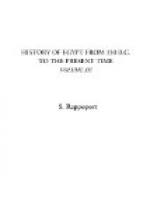* Revue Archeologique, xxix., p. 127.
M. Edouard Naville found at Thebes many remains of the Punt sculptures. The Puntites appear with their aquiline features, their pointed beards, and their long hair; negroes also of black and brown varieties are represented adjoining the Puntites proper. There are wickerwork huts, and a figure of a large white dog with its ears hanging down. Long-billed birds also appear flying about in the trees. Their nests have been forsaken and robbed, and the men are represented as gathering incense from the trees. Altogether, much invaluable information has been gathered concerning the famous people who lived in the Land of Punt, and with whom for a long period the Egyptians held intercommunication. Other discoveries were made near the great temple of Karnak, and the buildings of Medinet-Habu were cleared of rubbish in order to show their true proportions.
From its foundation, the Egypt Exploration Fund has received large pecuniary support from the United States, chiefly through the enthusiasm and energy of Dr. W. C. Winslow, of Boston. In 1880 Doctor Winslow, who had been five months in Egypt, returned to America deeply impressed with the importance of scientific research in Egypt, and, upon hearing of the Exploration Fund in London, he wrote a letter expressive of his interest and sympathy to the president, Sir Erasmus Wilson, which brought a reply not only from him, but also from the secretary, Miss Edwards, expatiating upon the purpose and needs of the society, and outlining optimistically its ultimate accomplishments.
Doctor Winslow was elected honorary treasurer of the Fund for the United States for the year 1883-84.* Many prominent residents became interested and added their names to its membership, and have given it their effort and their hearty financial support. Among the distinguished American members have been J. R. Lowell, G. W. Curtis, Charles Dudley Warner, and among the chief Canadian members are Doctor Bourinot and Dr. J. William Dawson.




